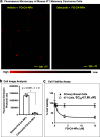Polymeric Nanoparticles Enable Targeted Visualization of Drug Delivery in Breast Cancer
- PMID: 40257460
- PMCID: PMC12056698
- DOI: 10.1021/acs.molpharmaceut.4c00695
Polymeric Nanoparticles Enable Targeted Visualization of Drug Delivery in Breast Cancer
Abstract
We report the coencapsulation of fluorocoxib Q (FQ) and chemocoxib A (CA) in micellar nanoparticles (FQ-CA-NPs) of a new PPS135-b-POEGA17 diblock polymer, which exhibited a hydrodynamic diameter of 109.2 ± 4.1 nm and a zeta potential (ζ) of -1.59 ± 0.3 mV. The uptake of FQ-CA-NPs by 4T1 mouse mammary cancer cells and intracellular cargo release were assessed by fluorescence microscopy that resulted in increased fluorescence in 4T1 cells compared to cells pretreated with celecoxib. The viability of primary human mammary epithelial cells (HMECs) or 4T1 mouse mammary carcinoma cells treated with FQ-CA-NPs were assessed, which showed decreased growth of 4T1 breast cancer cells but showed no effect on the growth of primary human mammary epithelial cells (HMECs). Intravenous dosing of FQ-CA-NPs in mice enabled ROS-induced cargo (FQ and CA) release and fluorescence activation of FQ and resulted in increased fluorescence in breast tumors compared to the tumors of animals pretreated with tempol or celecoxib, and minimum fluorescence was detected in the tumors of animals treated with nothing or empty-NPs. In addition, tumor tissues from treated animals were analyzed ex vivo by liquid chromatography-mass spectrometry (LC-MS)/MS, and identified increased levels of cargo delivery and retention in the tumor compared to tempol- or celecoxib-pretreated animal tumors. These in vivo and ex vivo results confirmed the targeted delivery of loaded NPs followed by ROS-mediated cargo release and fluorescence activation for targeted visualization of drug delivery in breast tumors and CA-induced therapeutic effect in an in vivo tumor growth inhibition assay and an ex vivo hematoxylin and eosin (H&E) staining of tumor tissues. Thus, coencapsulation of FQ and CA into polymeric micellar nanoparticles (FQ-CA-NPs) enabled their ROS-sensitive release followed by fluorescence activation and COX-2-dependent tumor targeting and retention in the visualization of CA delivery in solid breast tumors.
Keywords: chemocoxib A; drug delivery; fluorocoxib Q; micellar nanoparticles; tumor imaging.
Conflict of interest statement
The authors declare no competing financial interest.
Figures




Similar articles
-
Polymeric Micellar Nanoparticles Enable Image-guided Drug Delivery in Solid Tumors.bioRxiv [Preprint]. 2025 Feb 19:2024.06.07.598019. doi: 10.1101/2024.06.07.598019. bioRxiv. 2025. PMID: 38915607 Free PMC article. Preprint.
-
Self-Assembled Dual-Targeted Epirubicin-Hybrid Polydopamine Nanoparticles for Combined Chemo-Photothermal Therapy of Triple-Negative Breast Cancer.Int J Nanomedicine. 2020 Sep 11;15:6791-6811. doi: 10.2147/IJN.S260477. eCollection 2020. Int J Nanomedicine. 2020. PMID: 32982234 Free PMC article.
-
ROS-Responsive Nanoprobes for Bimodal Imaging-Guided Cancer Targeted Combinatorial Therapy.Int J Nanomedicine. 2024 Aug 7;19:8071-8090. doi: 10.2147/IJN.S467512. eCollection 2024. Int J Nanomedicine. 2024. PMID: 39130685 Free PMC article.
-
A Mechanistic Understanding of Reactive Oxygen Species (ROS)-Responsive Bio-Polymeric Nanoparticles: Current State, Challenges and Future Toward Precision Therapeutics.Biopolymers. 2025 May;116(3):e70027. doi: 10.1002/bip.70027. Biopolymers. 2025. PMID: 40370134 Review.
-
Engineering immunity using metabolically active polymeric nanoparticles.Trends Biotechnol. 2025 Jun;43(6):1371-1384. doi: 10.1016/j.tibtech.2024.11.016. Epub 2024 Dec 27. Trends Biotechnol. 2025. PMID: 39732608 Review.
References
-
- Ghezzi M.; Pescina S.; Delledonne A.; Ferraboschi I.; Sissa C.; Terenziani F.; Remiro P. F. R.; Santi P.; Nicoli S. Improvement of Imiquimod Solubilization and Skin Retention via TPGS Micelles: Exploiting the Co-Solubilizing Effect of Oleic Acid. Pharmaceutics 2021, 13 (9), 1476.10.3390/pharmaceutics13091476. - DOI - PMC - PubMed
-
- Ghezzi M.; Pescina S.; Padula C.; Santi P.; Del Favero E.; Cantu L.; Nicoli S. Polymeric micelles in drug delivery: An insight of the techniques for their characterization and assessment in biorelevant conditions. J. Controlled Release 2021, 332, 312–336. 10.1016/j.jconrel.2021.02.031. - DOI - PubMed
MeSH terms
Substances
LinkOut - more resources
Full Text Sources
Medical
Research Materials

